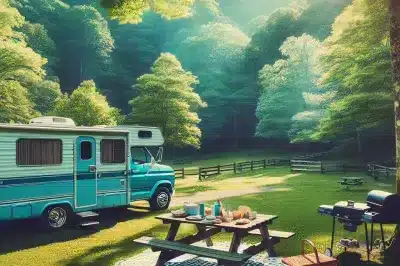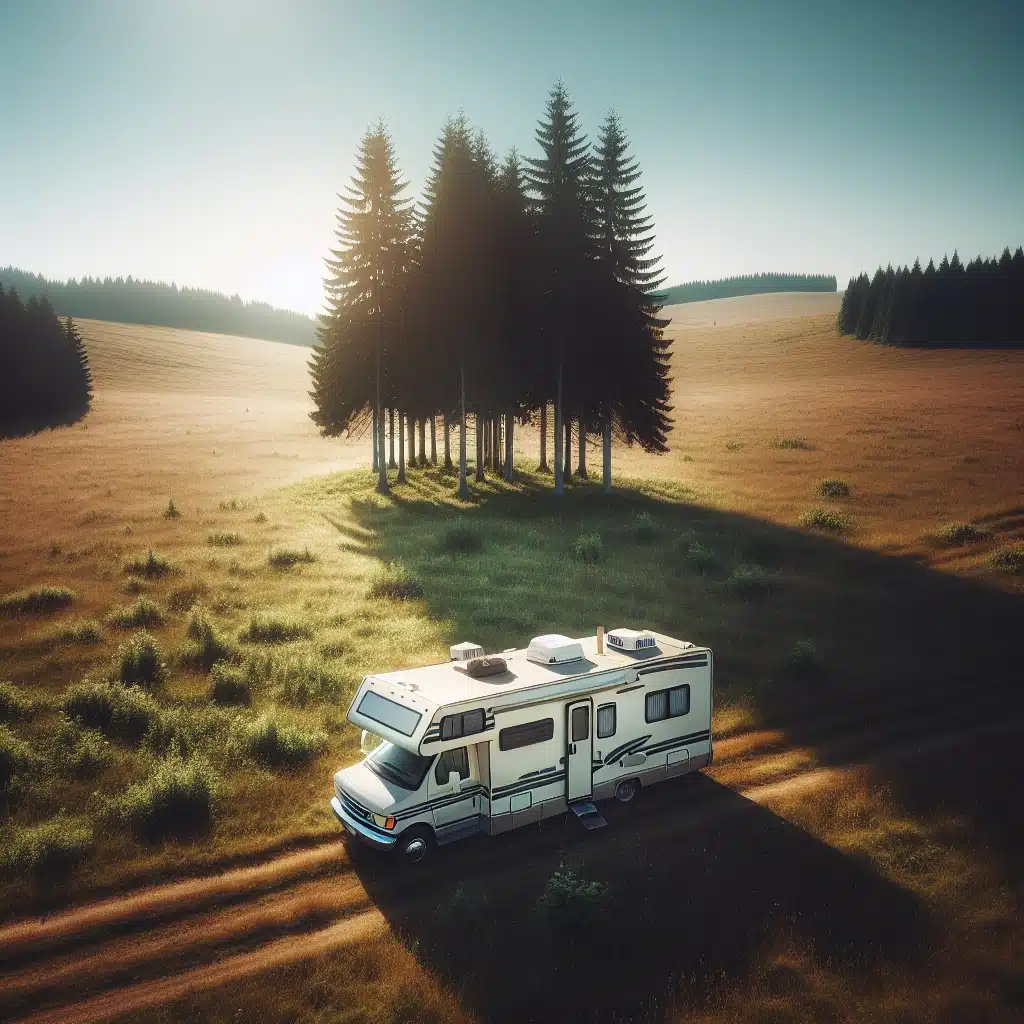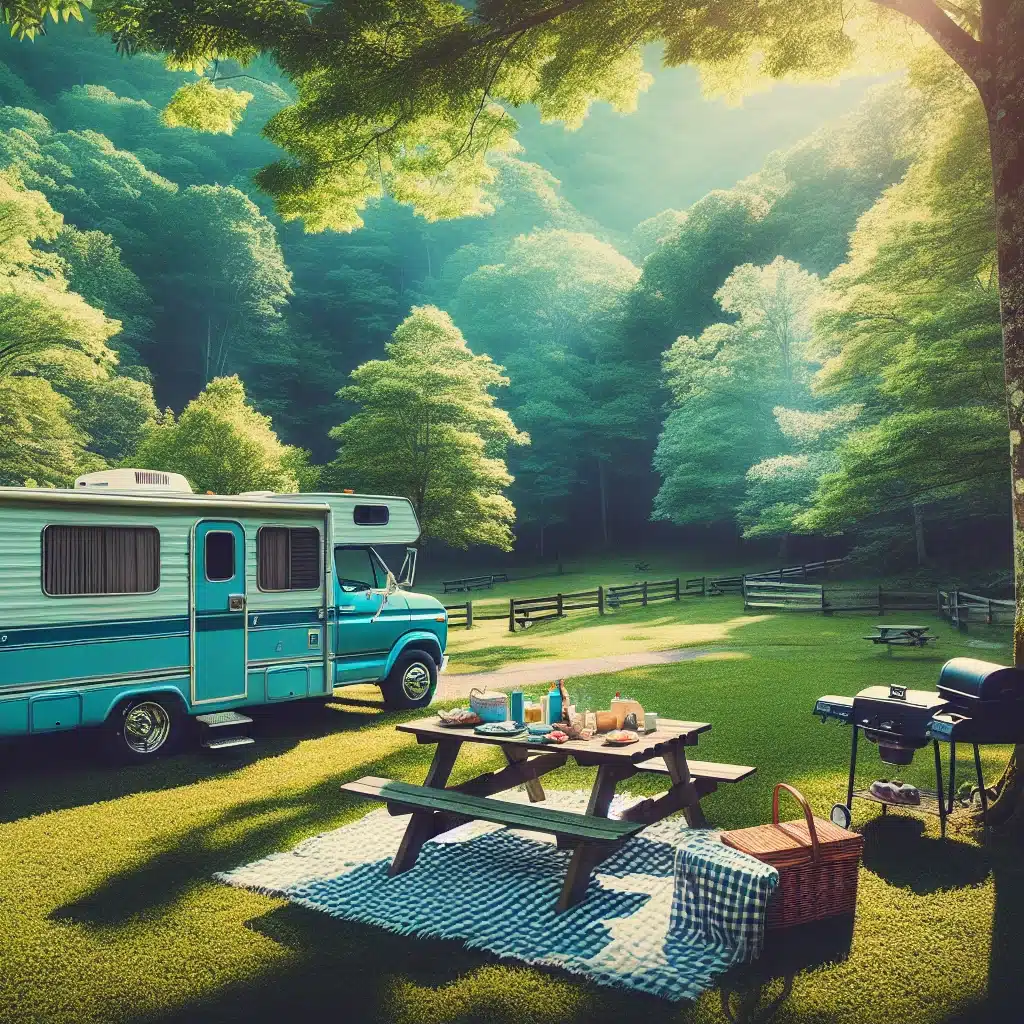Table of Contents

Harness the Sun: Powering Your Boondocking Adventures
Imagine waking up to the gentle rays of dawn, your RV nestled in a remote paradise, far from the hum of the grid. This is the boondocker’s dream, and solar power is your ticket to making it a reality. With the right setup, you can soak up the sun’s energy and use it to power your RV’s essentials, from lights to refrigerators, all while maintaining your freedom to roam.
Maximizing Solar Efficiency on the Road
Efficiency is key when it comes to solar power, especially in the ever-changing environments of the open road. To get the most out of your solar panels, you’ll want to park your RV so that it gets maximum sun exposure. Remember, even a little shade can significantly reduce your solar panel’s performance. Tilt your panels towards the sun and consider using a solar tracker for the best results. It’s all about capturing as much sunlight as possible to keep your batteries charged and your adventures going.
Here are some quick tips to boost your solar efficiency:
- Keep your solar panels clean – dust and debris can block sunlight.
- Use energy-efficient appliances to reduce your overall power consumption.
- Monitor your power usage with a solar power meter to understand your energy needs.
- Upgrade to MPPT (Maximum Power Point Tracking) solar charge controllers for better energy conversion.
- Consider your RV’s orientation and move it throughout the day if necessary to follow the sun’s path.
Understanding Your RV’s Solar Power Capacity
Before diving into the solar-powered lifestyle, it’s crucial to know your RV’s power needs. Start by listing all your appliances and their wattage requirements. Next, calculate the total energy consumption you’ll have on a typical day. This will give you a clear idea of the solar power capacity required to sustain your boondocking lifestyle. Remember, it’s always better to overestimate your needs a bit to avoid running out of power when you least expect it.
Example: If your daily energy usage adds up to 2kWh, you’ll want a solar system that can generate that amount on an average day. Don’t forget to factor in the efficiency losses from the charge controller and inverter!
Now that you’ve got a handle on your energy needs, let’s talk about the gear you’ll need to make the most of the sun’s bounty.
Essential Gear for Solar-Powered Boondocking
Equipping your RV for solar power involves more than just slapping some panels on the roof. You’ll need a few key components to capture, store, and use that solar energy efficiently. Let’s take a look at what you’ll need to get started.
Choosing the Right Solar Panels
Solar panels are the stars of the show, converting sunlight into electric power. But not all panels are created equal. You’ll want to choose panels that offer the best performance for your specific needs. Look for panels with a high wattage rating and efficiency to get the most power in the least amount of space. Flexible panels are great for curved RV roofs, while rigid panels might last longer and withstand harsher conditions.
When selecting solar panels, consider:
- The size of your RV’s roof and the amount of space available for panels.
- The wattage and efficiency of the panels to meet your energy needs.
- The type of solar cells used in the panels, with monocrystalline being the most efficient.
- Warranty and durability, because you want panels that can handle the rigors of the road.
Solar Charge Controllers: Your System’s Best Friend
A solar charge controller is a critical component that protects your batteries from being overcharged by regulating the voltage and current coming from your solar panels. It’s the heart of your solar setup, ensuring that your batteries stay healthy and your system runs smoothly. There are two main types of controllers: PWM (Pulse Width Modulation) and MPPT (Maximum Power Point Tracking). MPPT controllers are more efficient and can boost your system’s performance, especially in varied weather conditions.
When choosing a solar charge controller, keep in mind:
- The type of controller (PWM vs. MPPT) and its compatibility with your solar panels.
- The maximum input voltage and current it can handle to match your solar array.
- Any additional features like LCD displays, USB ports, or remote monitoring capabilities.
Batteries: The Heart of Your Off-Grid Power
Batteries store the power your solar panels generate, so you can use it when the sun isn’t shining. Think of them as your personal power bank. The most common types for RV use are lead-acid and lithium batteries. Lithium batteries are lighter and last longer but come with a higher price tag. Lead-acid batteries are more budget-friendly but require regular maintenance and are heavier.
Here’s what to keep in mind when selecting batteries:
- Capacity: Measured in amp-hours (Ah), it tells you how much power a battery can store.
- Lifespan: Consider how many charge cycles the battery can handle before it needs replacing.
- Type: Lithium batteries are more efficient, but lead-acid batteries are more cost-effective.
- Maintenance: Lead-acid batteries need regular checks and topping up with distilled water.
Power Inverters: Converting Sunlight to Usable Energy
Power inverters are the magic boxes that turn the DC power from your solar panels and batteries into the AC power that most of your RV appliances use. Without an inverter, you’d be stuck with DC-only devices. The size of the inverter you’ll need depends on the total wattage of the appliances you want to run at the same time.
When shopping for inverters, consider:
- Wattage: Make sure the inverter can handle the combined wattage of your appliances.
- Pure sine wave vs. modified sine wave: Pure sine wave inverters are better for sensitive electronics.
- Efficiency: Look for an inverter with a high efficiency rating to get the most out of your power.

Installation Best Practices
Proper installation is crucial for a safe and efficient solar power system. It’s not just about placing panels on the roof; it’s about integrating the system into your RV in a way that maximizes performance and minimizes risks.
Optimal Panel Placement for Maximum Power
Panel placement can make or break your solar setup. The goal is to capture as much sunlight as possible throughout the day. Avoid placing panels under AC units or vents that might cast a shadow. Also, consider the angle of the panels; sometimes, a slight tilt towards the sun can significantly increase your energy harvest.
Remember these tips for the best placement:
- Keep panels clear of shadows from trees, vents, or other obstructions.
- Mount panels securely to withstand high winds and bumpy roads.
- Adjust the tilt angle seasonally to follow the sun’s path for optimal charging.
Weatherproofing and Maintenance Tips
Your solar system will face all kinds of weather, so it’s important to protect it. Use weather-resistant materials for mounting and sealing to prevent leaks. Regularly check the connections and clean the panels to ensure they’re operating efficiently.
Keep your system in top shape with these maintenance tips:
- Inspect seals and mounts twice a year for signs of wear and tear.
- Clean your solar panels with a soft cloth and soapy water to remove dirt and grime.
- Tighten connections and check for corrosion, especially after driving in harsh conditions.
Solar Power Management While Boondocking
Managing your solar power effectively is crucial when you’re off the grid. Monitor your system’s performance, keep an eye on battery levels, and be mindful of your energy consumption. Use energy-efficient appliances and LED lighting to stretch your power further.
Stay powered up with these management strategies:
- Use a solar charge controller with a display to monitor input and output.
- Invest in a battery management system to keep track of charge levels and health.
- Plan your energy usage around peak sunlight hours to maximize charging.
- Reduce power consumption by unplugging devices when not in use and using natural light during the day.
Monitoring Your Energy Consumption
Keeping a close eye on how much energy you’re using is like watching your fuel gauge on a long drive—it’s essential. A good monitoring system will show you how much power you’re drawing at any time and how much you have left. This way, you can adjust your usage before your batteries run too low. Think of it as your personal energy advisor, guiding you to make smart decisions about when to conserve and when you can indulge a little.
Here’s what to monitor for efficient energy management:
- Battery voltage to determine the state of charge.
- Current (amps) going in and out of your batteries.
- Energy consumption (watt-hours) of your appliances.
- Remaining battery capacity to estimate available power.
- Solar panel output to track your energy production.
Smart Energy Practices to Extend Your Stay
Adopting smart energy habits can make all the difference in how long you can enjoy the wilderness. Use natural light during the day, switch to LED bulbs, and turn off appliances when they’re not in use. Consider cooking with a solar oven or a propane stove to save electricity. And remember, the more you conserve, the longer your batteries will last, and the longer you can stay off the grid.
Extend your boondocking stay with these energy-saving tips:
- Insulate your RV to maintain temperature and reduce heating and cooling needs.
- Charge gadgets during peak solar hours to avoid draining batteries at night.
- Use a thermal cooker to save energy on meals.
- Set your fridge to a higher temperature that’s still safe for food storage.
- Take advantage of campground facilities when available to save your RV’s resources.

Troubleshooting Common Solar System Issues
Even the best solar setups can encounter issues, but don’t let that dim your adventure. Most problems have simple solutions, and with a little know-how, you’ll be back to enjoying your off-grid freedom in no time. From panels not charging to batteries not holding a charge, we’ll cover how to troubleshoot these common hiccups.
Dealing With Insufficient Solar Charge
If you find your batteries aren’t charging as they should, first check for any obstructions like branches or dirt on your panels. Ensure all connections are secure and corrosion-free. If your system is still underperforming, it might be time to reassess your energy needs versus your solar capacity. Sometimes, adding more panels or upgrading your batteries is the best solution.
Address insufficient solar charge with these steps:
- Clean your solar panels regularly to ensure maximum light absorption.
- Reposition your RV or panels throughout the day to catch more sunlight.
- Check for damaged or worn wires and connections.
- Consider upgrading to a more efficient solar charge controller.
- Assess your energy usage and cut back on non-essential power draws.
Ensuring the Longevity of Your RV Solar System
A solar power system is a significant investment, and like any investment, you want it to last. Regular maintenance is key. Keep your panels clean, check your batteries’ water levels if they’re lead-acid, and ensure all connections are tight and corrosion-free. Treat your system well, and it will keep you powered up for many adventures to come.
Maintain your solar system’s longevity with these practices:
- Perform routine inspections of all solar components.
- Keep the battery terminals clean and properly tightened.
- Update firmware for any digital controllers or monitors.
- Store your RV in a way that protects the solar panels when not in use.
- Follow the manufacturer’s guidelines for all solar equipment.
Preparing for a Solar Boondocking Trip
Before you head out into the great unknown, a little preparation can go a long way. Make sure your solar system is up to the task, pack any extra gear you might need, and plan your route to take advantage of the sunniest spots. A well-prepared boondocker is a happy boondocker.
Get ready for your solar boondocking adventure with these steps:
- Test your solar system to ensure it’s fully functional.
- Charge your batteries to full before leaving.
- Pack spare parts like fuses, wires, and connectors.
- Plan your stops to ensure you’ll have enough sunlight for charging.
- Bring a backup power source, such as a generator, just in case.
Checklist for Solar Equipment and Accessories
Before you hit the road, let’s make sure you’ve got all the solar equipment and accessories you’ll need for a successful boondocking trip. Here’s a checklist to help you pack:
- Solar panels – Enough to meet your energy needs.
- Solar charge controller – To regulate power to the batteries.
- Deep cycle batteries – For storing your solar power.
- Power inverter – To convert DC to AC power for your appliances.
- Mounting hardware – For securing panels to your RV.
- Wiring and connectors – To link your system components.
- Monitoring system – To keep track of your power usage.
- Cleaning supplies – For panel maintenance.
- Fuses and circuit breakers – For system protection.
- Extra cables and parts – Because it’s always good to have backups.
With this gear in tow, you’ll be well on your way to enjoying the freedom that solar-powered boondocking has to offer.
Understanding and Preparing for the Limitations of Solar Power
Solar power offers incredible freedom, but it’s not without its limitations. Understanding these will help you prepare for a smooth boondocking experience. For instance, solar power depends on sunlight, which can be inconsistent. Bad weather can reduce your system’s output, and shorter winter days mean less charging time.
Prepare for these limitations by:
- Planning your energy use around the forecast and sunlight hours.
- Having a backup generator for extended periods of poor weather.
- Bringing portable solar panels to reposition for optimal sun exposure.
- Conserving energy by using energy-efficient appliances and LED lighting.
- Understanding that you might need to adjust your lifestyle to fit your energy availability.
Key Takeaways
Let’s sum up the essential points to remember for your solar-powered boondocking adventures:
- Maximize solar efficiency by parking in sunny spots and keeping panels clean.
- Know your RV’s energy needs to determine the right solar power capacity.
- Equip your RV with the necessary solar gear, including panels, batteries, and a charge controller.
- Be aware of the limitations of solar power and prepare with backup plans and energy conservation.
- Use a checklist to ensure you have all the solar equipment and accessories for your trip.
Frequently Asked Questions (FAQ)
What size solar panel do I need for boondocking?
The size of the solar panel you need depends on your energy usage. Start by calculating the total wattage of the appliances you’ll be using and how many hours you’ll use them each day. Then, consider the average sun hours you’ll get in the locations you plan to visit. A safe bet is to aim for a solar panel system that can generate 30-40% more power than your estimated daily usage to account for inefficiencies and unexpected energy needs.
Can I use solar power for all my RV appliances while boondocking?
Yes, you can use solar power for all your RV appliances, but you’ll need a system that’s sized correctly for your energy demands. High-energy appliances like air conditioners and microwaves will require a significant amount of power, so you’ll need more solar panels and battery capacity. It’s also smart to use appliances sparingly and opt for energy-efficient versions whenever possible to make the most of your solar power.
How can I estimate my solar power needs before a trip?
Estimating your solar power needs is like planning your provisions for a long hike. You need to know how much you’ll consume so you can pack accordingly. Start by making a list of all the electrical devices you plan to use and note their wattage. Multiply the wattage by the number of hours you’ll use each device to calculate the watt-hours per day. Add up the watt-hours for all devices to get your daily consumption. Remember to factor in the inefficiencies of the system and the potential for less-than-ideal weather conditions. This will give you a ballpark figure of the solar power capacity you’ll need to enjoy your trip without running out of juice.
Here’s a simple way to estimate your solar power needs:
– List all electronic devices and their wattage.
– Calculate the daily watt-hours for each device.
– Sum the daily watt-hours for all devices to find total daily consumption.
– Factor in inefficiencies and weather conditions by adding an extra 25-40% to your total.
What maintenance does my RV solar system require?
Maintenance is the guardian of your solar system’s longevity. It’s all about keeping your panels clean and your connections secure. Regularly clean your panels with water and a non-abrasive cloth to prevent dirt build-up that can block sunlight. Check all electrical connections for signs of corrosion or wear and ensure they’re tight. For battery maintenance, if you’re using lead-acid batteries, check the water level and refill with distilled water as needed. Keep an eye on your charge controller and inverter, ensuring they’re not displaying any error messages and are functioning correctly. A well-maintained solar system not only lasts longer but also performs better, ensuring you have power when you need it most.
Regular maintenance tasks include:
– Cleaning solar panels to ensure maximum efficiency.
– Inspecting and tightening electrical connections.
– Maintaining batteries, especially if they’re lead-acid type.
– Monitoring charge controllers and inverters for proper operation.
How do I align my solar panels for optimal sun exposure?
Aligning your solar panels correctly is like positioning a sail to catch the wind. It’s all about finding that sweet spot where your panels can drink in the most sunlight. The angle of your panels should match the latitude of your location to maximize exposure. If you’re staying put for a while, adjust the tilt of your panels as the seasons change, since the sun’s path shifts in the sky. If you’re on the move, consider portable or adjustable mounts that allow you to reposition your panels throughout the day. A little effort in alignment can lead to a significant boost in your solar power harvest.
– To align your solar panels for optimal sun exposure:
– Match the tilt angle of your panels with the latitude of your location.
– Adjust the angle seasonally to follow the sun’s path.
– Use portable or adjustable mounts to reposition panels during the day.
– Avoid placing panels under shadows and obstructions.
As we wrap up, let’s remember that boondocking with solar power is about freedom and self-sufficiency. It’s a way to connect with nature while respecting its resources. With the right solar setup, maintenance, and energy management, you can enjoy the great outdoors without leaving a trace. So, gear up, harness the sun, and set off on your next eco-friendly adventure with confidence.
And remember, every sunrise is an invitation to a new day of exploration, powered by the clean, silent energy of the sun. Happy boondocking!
- Boondocking RVs: Flexible Solar Solutions – 3 March 2024
- Renewable Energy Tips for Full-Time Boondocking RVers – 2 March 2024
- Boondocking Solar Power Systems: Sizing Options & Solutions for Motorhomes – 1 March 2024
